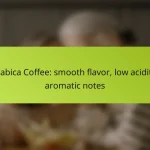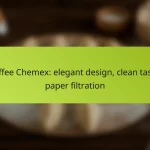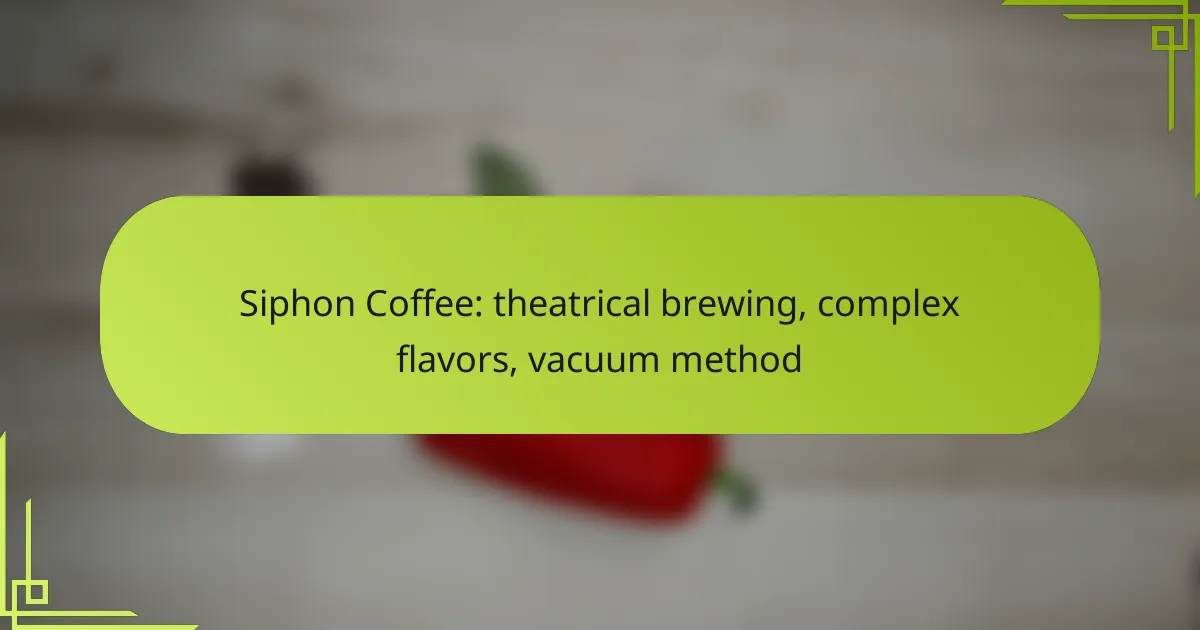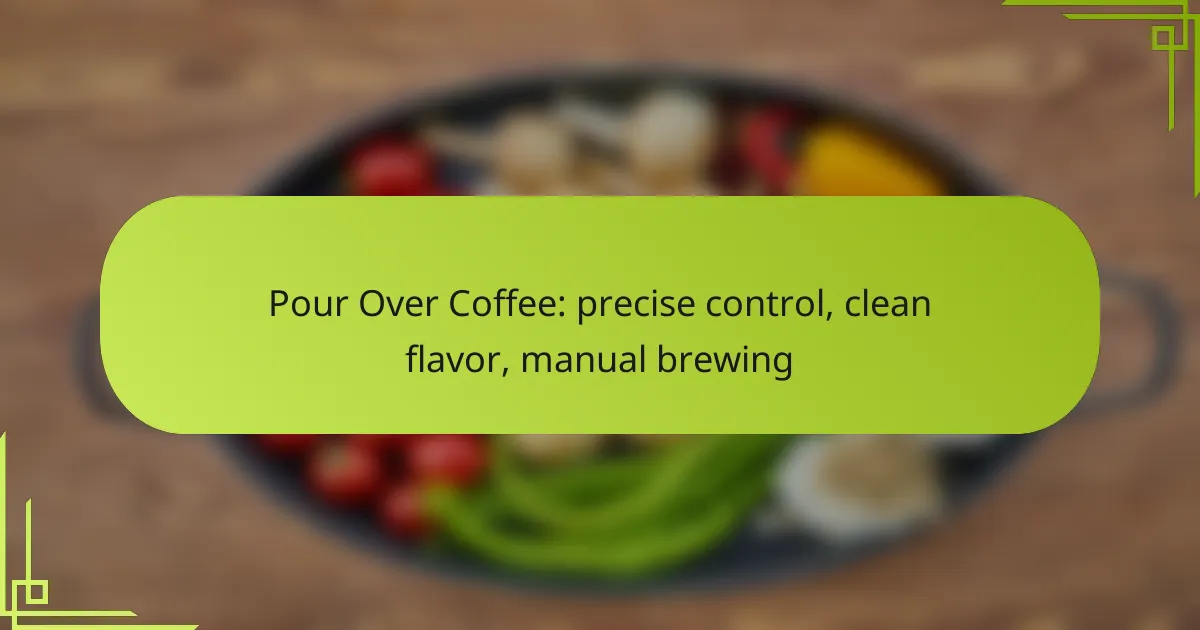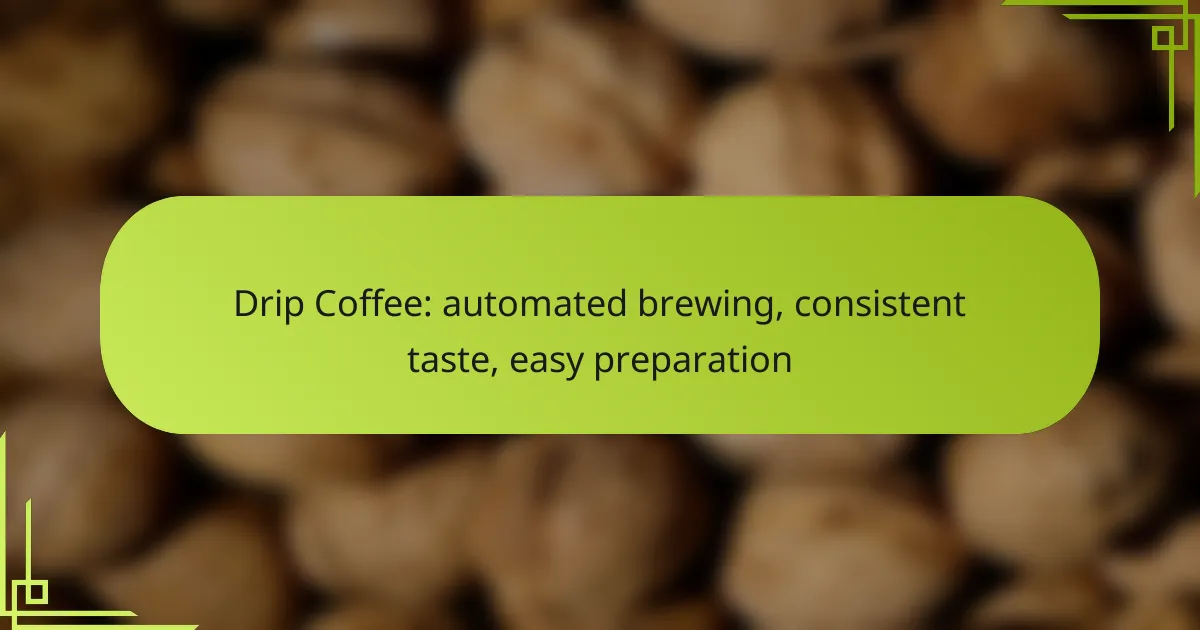Percolator coffee makers are renowned for their ability to brew coffee by cycling boiling water through coffee grounds multiple times, resulting in a strong and aromatic beverage. This classic brewing method not only enhances the flavor profile but also ensures consistency in each cup, making it a favorite among coffee enthusiasts seeking a robust experience.

How does a percolator coffee maker work?
A percolator coffee maker brews coffee by cycling boiling water through coffee grounds repeatedly. This method extracts robust flavors, resulting in a strong and aromatic cup of coffee.
Brewing process overview
The brewing process in a percolator involves heating water in a lower chamber until it boils. As the water heats, it rises through a tube into an upper chamber where it spills over the coffee grounds, infusing them with flavor.
This cycle continues until the desired strength is achieved, typically taking around 5 to 10 minutes. The repeated circulation of water ensures that the coffee grounds are thoroughly saturated, maximizing flavor extraction.
Key components of a percolator
A standard percolator consists of several key components: a water chamber, a coffee basket, a tube, and a heat source. The water chamber holds the water, while the coffee basket contains the coffee grounds.
The tube connects the water chamber to the coffee basket, allowing the brewed coffee to flow back down after passing through the grounds. Understanding these components helps in troubleshooting and optimizing the brewing process.
Water circulation mechanism
The water circulation mechanism is crucial for achieving the desired coffee strength. As water boils in the lower chamber, it creates steam pressure that forces the water up the tube and into the coffee basket.
This mechanism ensures that hot water continuously flows over the coffee grounds, extracting oils and flavors. It’s important to monitor the brewing time, as over-extraction can lead to a bitter taste, while under-extraction may result in a weak brew.
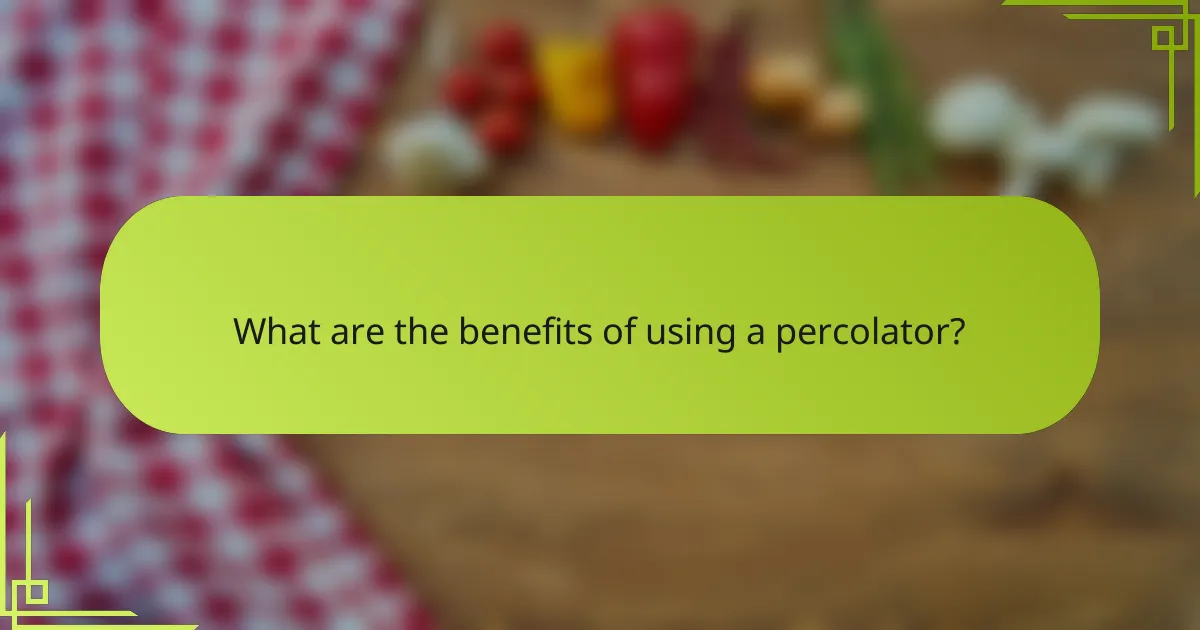
What are the benefits of using a percolator?
Using a percolator offers several advantages, including a rich flavor profile and consistent brewing results. This classic method of coffee preparation allows for repetitive brewing, ensuring that each cup is robust and satisfying.
Rich and robust flavor
Percolators are known for producing coffee with a deep and intense flavor. The brewing process involves cycling boiling water through the coffee grounds multiple times, which extracts oils and flavors effectively. This method often results in a stronger brew compared to drip coffee makers.
Many coffee enthusiasts appreciate the bold taste that percolators deliver. The ability to control the brewing time can further enhance the richness, allowing users to experiment with different strengths according to their preferences.
Consistent brewing temperature
One of the key benefits of percolators is their ability to maintain a consistent brewing temperature. The water is heated to just below boiling, which is optimal for extracting flavors without burning the coffee. This stability helps in achieving a uniform taste across multiple brews.
For best results, ensure that the heat source is steady. Using a stovetop percolator on low to medium heat can help maintain this ideal temperature, leading to a more balanced flavor profile.
Cost-effective and durable
Percolators are generally more affordable than many modern coffee machines, making them a cost-effective choice for coffee lovers. They often have fewer electronic components, which contributes to their durability and longevity.
With proper care, a percolator can last for many years, providing consistent quality without the need for frequent replacements. This makes it a practical investment for those who enjoy brewing coffee regularly.
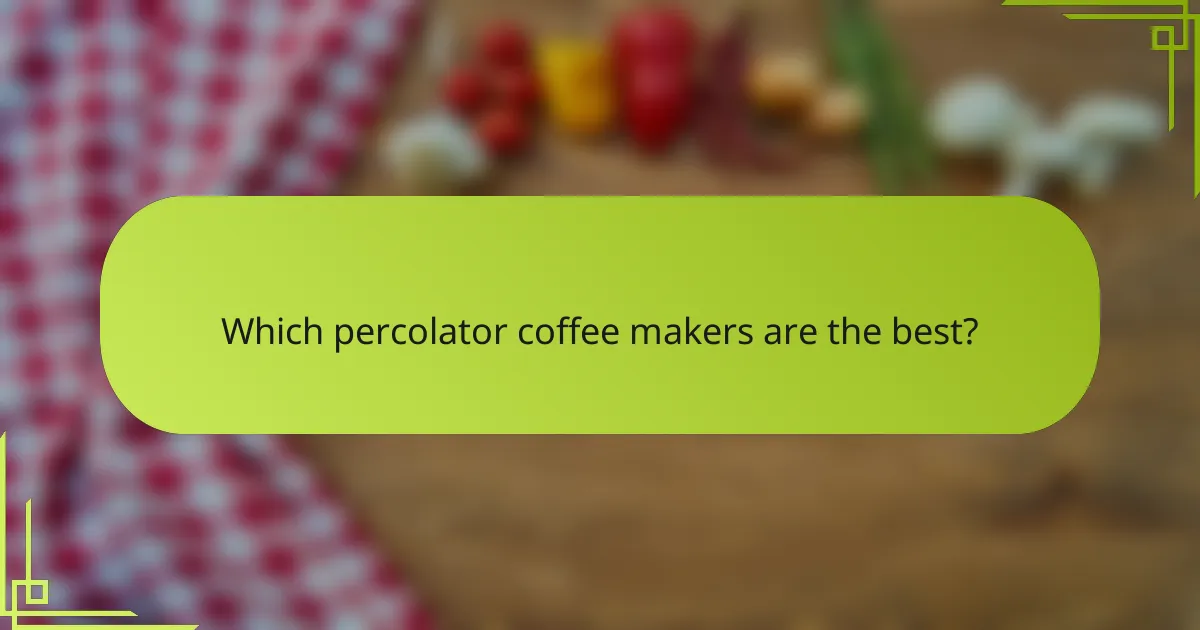
Which percolator coffee makers are the best?
The best percolator coffee makers combine traditional brewing methods with robust flavor, offering a unique coffee experience. Popular models include those known for their durability, ease of use, and ability to produce rich, full-bodied coffee.
Farberware Classic Percolator
The Farberware Classic Percolator is a timeless choice for coffee enthusiasts. Made of stainless steel, it not only looks elegant but also ensures even heat distribution for optimal brewing. This model typically brews about 8 to 12 cups of coffee, making it suitable for both small and larger gatherings.
When using the Farberware, it’s essential to monitor the brewing time, as over-percolating can lead to bitter flavors. A good rule of thumb is to let it brew for about 5 to 10 minutes, depending on your taste preference.
Presto 02811 12-Cup Stainless Steel Percolator
The Presto 02811 is known for its efficiency and capacity, brewing up to 12 cups of coffee quickly. Its stainless steel construction not only enhances durability but also contributes to the coffee’s flavor profile. This model features an automatic keep-warm function, ensuring your coffee stays hot without overcooking.
For best results, use medium grind coffee and avoid packing the filter basket too tightly. This will help maintain the rich flavor while preventing clogging during the brewing process.
Hamilton Beach 40514R Percolator
The Hamilton Beach 40514R is a user-friendly percolator that combines simplicity with functionality. It brews up to 12 cups and features a clear-view knob that allows you to monitor the brewing process easily. Its lightweight design makes it portable, perfect for camping or travel.
To maximize flavor, consider using freshly ground coffee and experiment with different brewing times. A brewing duration of around 8 minutes generally yields a well-balanced cup, but you can adjust based on your taste preferences.

How to brew coffee with a percolator?
Brewing coffee with a percolator involves a repetitive process that extracts robust flavors from the coffee grounds. This classic method requires attention to detail in measuring and timing to achieve the desired strength and taste.
Step 1: Gather ingredients and equipment
To brew coffee with a percolator, you’ll need a few essential items: a percolator, fresh coffee grounds, and water. Make sure your percolator is clean and in good working condition to ensure optimal flavor extraction.
For ingredients, choose high-quality coffee beans that suit your taste preferences. Whole beans are recommended, as they retain freshness longer than pre-ground coffee.
Step 2: Measure coffee grounds
The amount of coffee grounds you use will significantly affect the flavor. A general guideline is to use about 1 to 2 tablespoons of coffee per 6 ounces of water, depending on how strong you like your brew.
For a standard 12-cup percolator, this translates to roughly 3/4 to 1 cup of coffee grounds. Adjust the quantity based on your taste and the strength you desire.
Step 3: Start the brewing process
Fill the percolator’s water chamber with fresh water, then add the measured coffee grounds to the filter basket. Assemble the percolator and place it on the stove or heat source.
Heat the percolator until the water begins to boil, causing it to cycle through the coffee grounds. This process typically takes around 5 to 10 minutes. Keep an eye on the brewing to avoid over-extraction, which can lead to bitterness.
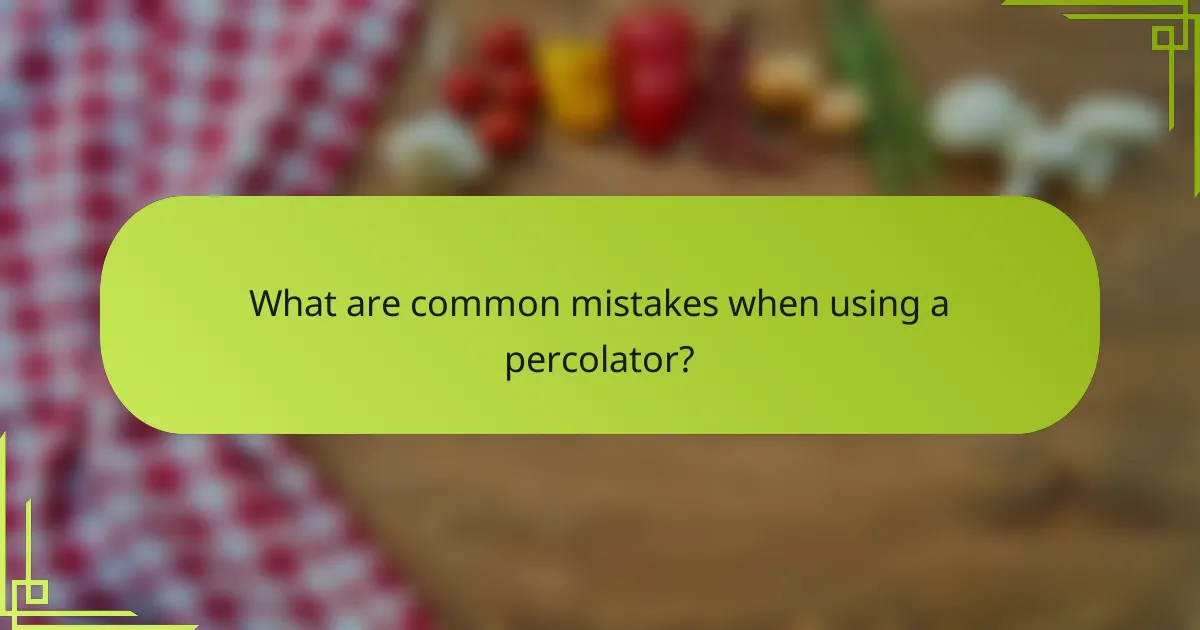
What are common mistakes when using a percolator?
Common mistakes when using a percolator include over-brewing coffee, using the wrong grind size, and neglecting cleaning and maintenance. These errors can lead to bitter flavors, inconsistent brewing, and a shorter lifespan for your coffee maker.
Over-brewing coffee
Over-brewing occurs when coffee is left in the percolator for too long, resulting in a bitter taste. Ideally, brewing should take around 5 to 10 minutes, depending on the desired strength. Monitoring the brewing process is essential to avoid this common pitfall.
To prevent over-brewing, consider using a timer or watching the percolator closely. Once you see the coffee bubbling through the top, it’s a good indication that it’s time to remove it from the heat.
Using incorrect grind size
The grind size of your coffee beans significantly impacts the brewing process in a percolator. A coarse grind is recommended, as a fine grind can lead to over-extraction and a gritty texture. Aim for a consistency similar to sea salt for optimal results.
Using the wrong grind size can also clog the filter, affecting the flow of water and resulting in uneven brewing. Always adjust your grind size based on your percolator’s specifications to achieve the best flavor.
Neglecting cleaning and maintenance
Regular cleaning and maintenance of your percolator are crucial for preserving its performance and flavor quality. Residue buildup can lead to off-tastes and affect the brewing efficiency. Clean your percolator after each use to maintain optimal flavor.
Use warm, soapy water for cleaning, and avoid abrasive materials that can scratch the surface. Additionally, consider descaling your percolator periodically, especially if you have hard water, to prevent mineral buildup that can impair functionality.

How to clean and maintain a percolator?
Cleaning and maintaining a percolator is essential for ensuring optimal flavor and longevity. Regular upkeep prevents coffee residue buildup, which can affect the taste of your brew.
Daily cleaning tips
After each use, disassemble your percolator and rinse all removable parts with warm water. Use a soft sponge to clean the pot and filter basket, avoiding abrasive materials that can scratch surfaces.
For best results, run a mixture of equal parts water and white vinegar through the percolator once a week. This helps to remove any lingering oils and keeps your coffee tasting fresh.
Deep cleaning methods
Every few months, perform a deep clean by soaking all removable components in a solution of warm water and baking soda for about 30 minutes. This will help to break down stubborn stains and buildup.
After soaking, scrub the parts gently with a non-abrasive brush, then rinse thoroughly with clean water. Ensure all components are completely dry before reassembling to prevent mold growth.
